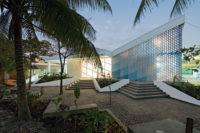Turkana, Kenya
Last year, architect José Selgas, of the Spanish firm SelgasCano, brought 10 architecture students from the Massachusetts Institute of Technology to an isolated desert region in northwest Kenya to design and build a vaccination and educational center serving the nomadic Turkana people. He hoped to interrupt the students' dependence on digital technologies and confront them with more basic questions of habitat and design. In the process, he also managed to upset romantic notions about the use of indigenous, ecologically sustainable materials such as thatch or adobe, which were ruled out by the client as too expensive to install and maintain. “They're for the luxury hotels, the tourists,” Selgas observes. “So you realize that it's a lot of our own prejudices that make us want to use these supposedly natural and honest materials. It was difficult for the students to understand this.”
The commission came from the Missionary Community of Saint Paul the Apostle, a Spanish NGO that fights endemic malaria, malnutrition, and other ills. After 20 years in the region, the missionaries found that their rudimentary concrete-block structures were poorly adapted to the extreme climate or to the customs and needs of the Turkana people, and turned to Selgas-Cano for a fresh approach. The firm is best known for cladding buildings in translucent, brightly colored plastics, as in its Congress Center in Cartagena, Spain, and for a design philosophy based on “rethinking everything and avoiding the already known,” in the words of Selgas's wife and partner Lucia Cano.
The students designed the project during an initial visit to Turkana in the spring, and four of them returned with Selgas in the summer to build the pavilion in a single month, training local people and using a few semi-skilled workers. With the approval of tribal elders, they sited the building between four acacia trees and developed a design that follows a segment of a circle, allowing for future growth. The canopy shelters a rounded office enclosed in concrete blocks they produced on-site. Rings of low stone walls for sitting complete the circle. The shaded area around the office is used for classes, as a waiting area for vaccinations, and for social events.
The structural system of metal tubes fixed in place by adjustable clamps allowed for quick assembly. The clamps permit movement in any direction, accommodating the off-kilter angles of the structural bays as well as the imperfect construction process. The team anchored the tubes against low walls and tied the roofing sheets to them with wire. Gaps between overlapping planes of tin at the top of the roof promote air circulation. An extra layer of vertical sheeting shields the southern and western exposures from the sun, while the structure opens up to the north.
The greatest satisfaction for Selgas and Cano has been the project's acceptance by the native population. Selgas reports, “Everyone gathers there in the afternoon. It's become a social center.” For Cano, one key to this success is that, as in the huts the Turkana build for themselves, there are no right angles. “Westerners insist that everything has to be straight in their buildings, but the Turkanas don't understand why. It's actually quite hard to make a straight line—you need a whole series of special tools. And curving spaces are very cozy and welcoming.”
PeopleClient: MCSPA Owner: MCSPA
Architect:
Personnel in architect's firm who should receive special credit:
Photographer(s): Size: 1,600 square feet Cost: $32,000 Completion Date: August 2014 |
Products
Structural system
Exterior cladding
Windows
Doors |













Post a comment to this article
Report Abusive Comment